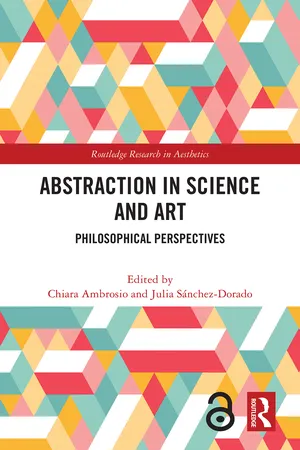
Abstraction in Science and Art
Philosophical Perspectives
- 248 pages
- English
- ePUB (mobile friendly)
- Available on iOS & Android
About this book
This volume explores the roles and uses of abstraction in scientific and artistic practice. Conceived as an interdisciplinary dialogue between experts across histories and philosophies of art and science, this collection of essays draws on the shared premise that abstraction is a rich and generative process, not reducible to the mere omission of details in a representation.
When scientists attempt to make sense of complex natural phenomena, they often produce highly abstract models of them. In the history and philosophy of art, there is a long tradition of debate on the function of abstraction, and – more recently – its relation with theories of depiction. Adopting a process-oriented perspective, the chapters in this volume explore the epistemic potential of a diversity of practices of abstracting. The systematic analysis of a wide range of historical cases, from early twentieth-century abstractionist painting to contemporary abstract photography, and from nineteenth-century physics to recent research in biology and neurosciences, invites the reader to reflect on the material lives of abstraction through concrete artefacts, experimental practices and theoretical and aesthetic achievements.
Abstraction in Science and Art will be of interest to scholars and advanced students working in aesthetics, philosophy of science, and epistemology, as well as to historians of science and art, and to practicing artists and scientists interested in exploring foundational questions at the heart of the creative practice of abstracting.
Frequently asked questions
- Essential is ideal for learners and professionals who enjoy exploring a wide range of subjects. Access the Essential Library with 800,000+ trusted titles and best-sellers across business, personal growth, and the humanities. Includes unlimited reading time and Standard Read Aloud voice.
- Complete: Perfect for advanced learners and researchers needing full, unrestricted access. Unlock 1.4M+ books across hundreds of subjects, including academic and specialized titles. The Complete Plan also includes advanced features like Premium Read Aloud and Research Assistant.
Please note we cannot support devices running on iOS 13 and Android 7 or earlier. Learn more about using the app.
Information
Table of contents
- Cover
- Half-Title Page
- Series Page
- Title Page
- Copyright Page
- Table of Contents
- List of Contributors
- Introduction: Abstraction in Science and Art
- 1 Selective Disregard
- 2 How Abstract Images Have Aboutness: An overview
- 3 Abstraction in Photography, Revisited
- 4 Bertrand Russell, Albert Barnes, and the Place of Aesthetics in the History of Western Philosophy
- 5 Abstracting as Manipulating Aspectual Structure: Jane Richardson’s Ribbon Drawings of Proteins
- 6 Moving Targets and Models of Nothing: A New Sense of Abstraction for Philosophy of Science
- 7 The Novel Naturalness of Abstract Space
- 8 Maxwell/Mondrian: Abstraction as a Process in Science and Art
- 9 Abstraction as Material Translation: An Artistic Reflection of (Re)Presentation
- 10 What If?
- Index